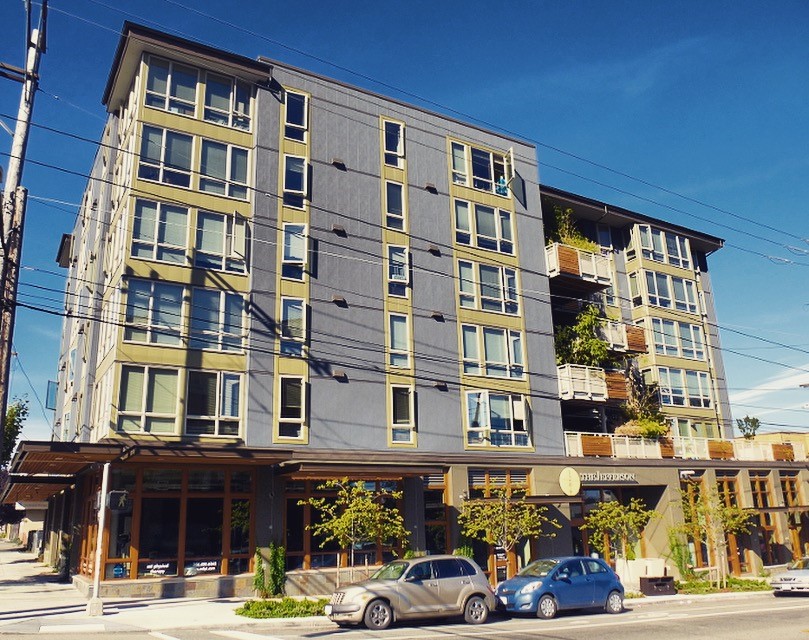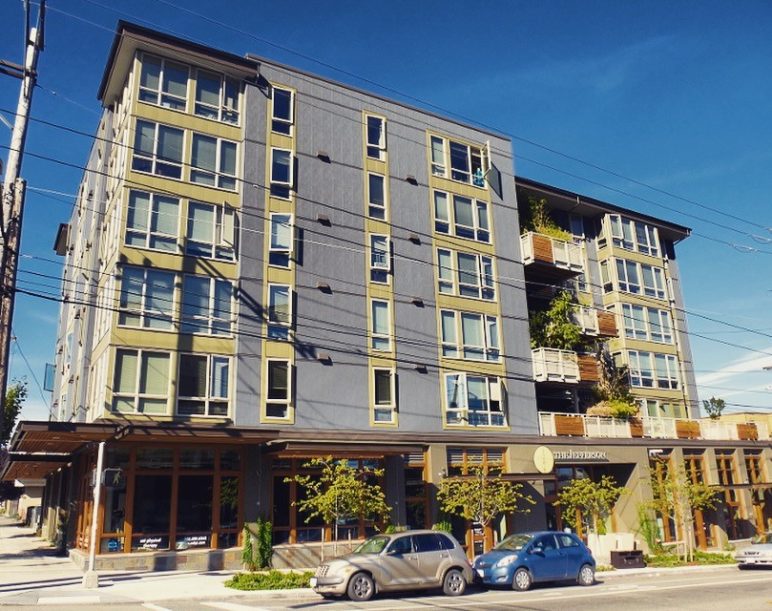It’s the first of May. As another rent day arrives, tenants aren’t the only ones seeking relief from the financial fallout of COVID-19, which has led to widespread job loss in nearly every economic sector, and the highest unemployment rate since the Great Depression.
Cascadian affordable housing providers that receive funding through the federal Low Income Housing Tax Credit (LIHTC) program, which helps to fund about 90 percent of all new affordable housing in the US, have also been hit hard by the crisis. Nonprofit providers of subsidized housing for low- and moderate-income wage earners report unpaid rent rates of 20 percent or more, a shortfall that has left many struggling to balance their books.
“Our delinquency rate shot way up, and we are now accepting partial payment for rent and doing some payment plans,” said Sharon Lee, the director of the Low Income Housing Institute, which serves communities throughout the Seattle metro area and in Olympia, Washington. “We’re working with tenants and doing partial payment plans for people who’ve recently become unemployed.”
In Oregon, about half the tenants in buildings owned by REACH Community Development earn income from wages. Anthony Petchel, REACH’s philanthropy and public relations director, says about 10 percent of their tenants had asked for rent forbearance as of late April, but he expected that number to go up as people continue to weather the economic collapse. “[The issue] is having the cash to manage the cash flow disruption” from missed rents, and “how long can all the organizations manage that,” Petchel says.
Daniel Delfino, the program and planning development director for the Alaska Housing Finance Corporation, said that once the 60-day rent and mortgage freeze ordered by Gov. Mike Dunleavy ends, there are few protections for struggling tenants or for nonprofit housing owners with mortgages to pay.
Currently, nonprofit landlords are working out arrangements with tenants on a “case by case basis,” he said, but with more than 40,000 Alaskans unemployed, it’s unclear when or whether rent payments will get back to normal. “There are usually reserves that are put in place to handle four to six months of operating expenses and debt payments. Those aren’t set up to handle something like COVID-19, when the economic occupancy”—the percentage of people who pay their rent—”goes down from 93 percent to 40 percent.”
Enterprise Community Partners, a national low-income housing advocacy and funding group, estimates that a 10 percent income loss among renters could add up to $238 million per month in losses to groups like these that run LIHTC-funded buildings across the US. That’s based on an average loss of $792 in monthly rent from the three million tenants in LIHTC buildings that Enterprise estimates could miss rent payments if they don’t get assistance.
Even with subsidized rents, out-of-work tenants may fall behind
Susan Boyd, the executive director of Seattle nonprofit provider Bellwether Housing, said wage earners had a delinquency rate of about 21 percent as of mid-April, up from 2 to 3 percent in a typical month, as “about 30 percent of the people who were wage earners have lost all or a part of their income.” Likewise, Chris Persons, the director of Seattle’s Capitol Hill Housing, said April rents are falling about 22 percent short.
It’s easy to see why. With a patchy social safety net, hourly wage earners were already on the precipice of financial disaster before a nationwide economic shutdown led to mass unemployment.
With a patchy social safety net, hourly wage earners were already on the precipice of financial disaster before a nationwide economic shutdown led to mass unemployment.

A full-time worker making minimum wage in Oregon earns just over $23,000 a year; in Washington, that number is just over $28,000. According to the Urban Institute, the median income for US renters in low-income tax credit buildings was $17,470 before COVID, and about four in ten of these renters spent more than 30 percent of their income on housing.
In King County, which includes Seattle, about 77,000 people making less than $40,000 a year had lost their jobs as of April 16; in Multnomah County, which includes Portland, about 38,000 low-income jobs had vanished. The pandemic puts the US housing crisis on steroids. Low-income renters often live paycheck to paycheck, and if they lose their jobs they simply can’t pay rent. The eviction moratoriums enacted in many jurisdictions throughout the US only grant a reprieve.
Non-profits are getting squeezed by more than just unpaid rent
Even organizations whose revenues don’t rely primarily on renter incomes—groups like Plymouth Housing and the Downtown Emergency Service Center in Seattle, whose tenants pay their rents using federal vouchers and stable income sources like Social Security Insurance (SSI)—are struggling.
“We rely a lot on local dollars, most of which come from specific local taxes and fees like the [state] document recording fee for housing and homelessness, and of course those could go down if real estate transactions slow down, which seems likely,” DESC director Daniel Malone said. “And as local government taxation goes down, there certainly could be some squeeze on what they choose to fund and what they choose to cut.”
On April 21, Seattle’s City Budget Office released a worst-case revenue forecast that predicts a 2020 funding shortfall of up to $300 million, with some of the biggest revenue losses coming from the construction, retail, and food service sectors. In Portland, a smaller city, the shortfall could be as much as $100 million.
The obliteration of retail stores and restaurants has also impacted non-profit housers directly. Rents from the commercial spaces in their apartment buildings can make up a significant chunk of operating revenues, and storefronts have been closed for more than a month. Paul Lambros, the director of Plymouth Housing, said his organization has “a dozen retail tenants that are closed up. We’ve deferred rent because we want them to come back.”
“We’re in the housing business, not the eviction business.”
While private-market landlords may be able to evict tenants who can’t pay the rent they owe once moratoriums are lifted, low-income housing providers say this isn’t really an option for them, especially in a recession. “We’re in the housing business, not the eviction business,” Persons said.
Susan Boyd, the CEO of Bellwether Housing, said, “What were we going to do—increase rents and kick people out? Who’s going to move in?” At the same time, nonprofits can’t afford to just stop charging rent for the duration of the COVID epidemic, as activists calling for a “rent strike” have advocated.
Many organizations have limited reserves that provide occasional assistance for tenants who can’t pay. Capitol Hill Housing ordinarily keeps about $50,000 on hand to pay up to 20 percent of a tenant’s rent, Persons said, but donations have increased the fund to $350,000 in recent weeks.
At the same time, though, they’ve incurred significant new expenses, including hazard pay for staff and deep cleaning in common areas to prevent the spread of the virus. Plymouth Housing is currently paying its staff time and a half to work through the pandemic, a policy that ordinarily applies to short-term emergencies like snow days. “This is a really long snow day, isn’t it?” Lambros said.
Non-profit housing providers call for renter assistance
Many nonprofit housing providers said they will be fine in the short term thanks to reserves and an increase in private contributions. (DESC, for example, received an unanticipated $1 million donation in April.) In the medium- to long-term, though, they said they (and their renters) will need some assistance, either in the form of direct government benefits to organizations or cash payments to renters.
“What we’re advocating for is either some kind of direct rent assistance for tenants or cash payments that would give renters the ability to pay their rent,” REACH’s Petchel said. That might include something like “an emergency universal income” or a “local version of Section 8, where local jurisdictions are providing that subsidy to make up the difference for tenants.”
Boyd said her primary priority right now is finding “ways to get people money so that they can pay their rent. Rental assistance from the grassroots up is the simple thing to do, it’s the most basic thing to do, and it’s the most important thing to do.
Rental assistance from the grassroots up is the simple thing to do, it’s the most basic thing to do, and it’s the most important thing to do.

” That means direct, “large-scale governmental intervention” in the form of expanded access to unemployment insurance and cash payments to tenants so that they can pay not just rent but other expenses, Boyd said.
Opponents of direct cash payments have argued that people will quit looking for jobs and squander the money on things like alcohol, tobacco, and lottery tickets. But as Margaret Morales and Michael Anderson have documented for Sightline, low-income people tend to use assistance money to pay for necessities, like rent, food, and education, and there’s scant evidence that people quit their jobs, or stop looking for work.
“Low-income people pay their rent before they pay anything else, and maybe they help other people pay their rent, so I don’t see people taking advantage” of direct payments, Boyd said. Cash payments would also help low-income families pay for other necessities unique to each household’s particular needs, like internet access, which has become critical as closed elementary schools have moved instruction online.
“You shouldn’t have to create a structure that bypasses the tenant,” said Marty Kooistra, the director of the King County Housing Development Consortium, which represents nonprofit housing developers. “The tenant should be made whole, and they, in turn, should pay their rent and make the organization whole.”
Federal legislation proposed by Washington state Congressman Denny Heck would provide up to $100 billion to fund rental assistance to people making up to 80 percent of the median income where they live. States would receive these subsidies through the existing Emergency Solutions Grant Program.
The Washington Low-Income Housing Alliance is taking a different approach, advocating at the state level for what WLIHA director Rachael Myers jokingly calls a “landlord bailout act,” which would provide payments directly to nonprofit housing providers “to keep their tenants housed and keep people in their homes” while also providing guaranteed rent income for the providers. In exchange for funding, landlords would be required to agree to extended tenant protections, such as a longer-term moratorium on evictions. Paying landlords directly would be one way to get rental assistance to undocumented tenants, who are ineligible for many federally funded COVID-19 assistance programs.
Other ways the federal government could help
The National Low-income Housing Alliance is also arguing for a $45 billion increase to the national Housing Trust Fund, which funds new affordable housing; the creation of a new emergency assistance fund for very low-income people facing “a short-term crisis that directly impacts their housing stability”; and a new tax credit for renters who spend more than 30 percent of their income on rent.
Other housing advocates and providers have argued for more funding to tenants and low-income property owners under the HOME (Housing Opportunity, Mobility, and Equity) Act and the extension of some deadlines that LIHTC properties are required to meet.
Several housing providers said they consider the COVID-19 crisis an opportunity to reconsider the nation’s approach to housing people who are low-income or homeless. Prior to the pandemic, Kooistra said, “we were living in a house of cards… relying on heroics and goodwill” to meet the needs of low-income people. “Hopefully, if there could be any silver lining out of this, it would be that society wakes up and says we need a much more equitable and sustainable way of approaching these really important challenges.”
Guest contributor Erica C. Barnett is a veteran reporter who covers Seattle politics and policy at The C Is for Crank.










